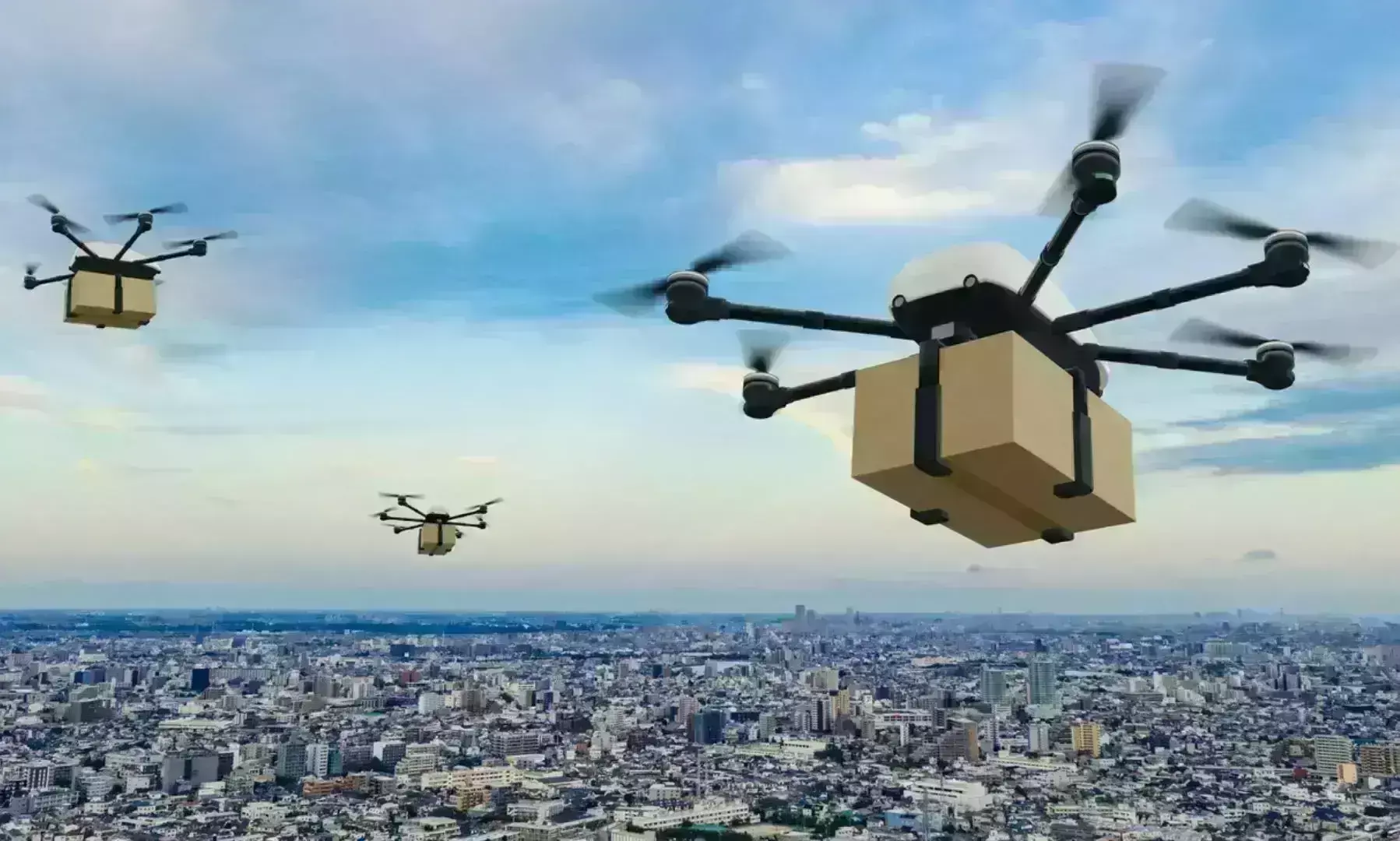
Cargo Drones: Emerging Applications and Regulations

Anticipated to reach $16.9 billion by 2032, the cargo drone market is reshaping logistics by swiftly delivering food, life-saving drugs, and essential goods. Yet, regulatory hurdles pose challenges to its rapid advancement.
When we talk about the air cargo industry, we often talk about the cargo aircraft that carry and transport huge amounts of cargo daily worldwide. While these aircraft are the backbone of the industry, the future has more to offer when it comes to cargo transportation. Cargo drones, also known as Unmanned Aerial Vehicles (UAVs), are revolutionising the way we deliver goods. These autonomous flying machines offer a glimpse into a future with faster, more efficient, and potentially greener logistics. Imagine you urgently require medication delivered to your doorstep. However, you either live far from the nearest pharmacy or reside in a remote area. But thanks to these drones, you can now receive essential medicines within minutes, similar to ordering food online.
In recent decades, UAVs or drones have gained a lot of attention from industries, investors, and governments. In today's world, drones are being used in many different ways across various industries, performing a wide range of tasks. From agriculture to construction, surveillance to entertainment, drones are used for precision farming, aerial surveys, monitoring, delivery services, and more. Their ability to access remote or hazardous locations and collect data with high precision makes them indispensable tools in modern operations. The size of drones typically determines their application.
Cargo drones come in a variety of shapes and sizes, each with its strengths for specific delivery needs. The most common type is the multi-rotor drone, with multiple propellers for lift and agility. These are ideal for quick urban deliveries because they can take off and land vertically (VTOL) in tight spaces. However, they're less efficient for long distances. For long-range travel, fixed-wing drones with aeroplane-like wings take the lead, offering superior efficiency but requiring runway takeoffs and landings. Hybrid VTOL drones combine the best of both worlds, providing vertical takeoff and landing like a multi-rotor but achieving long-distance flight efficiency like a fixed-wing. Finally, unmanned helicopters offer strong manoeuvrability and VTOL capabilities for carrying heavier payloads, although their long-range efficiency might be lower than fixed-wing designs.
Currently, there are four distinct applications for cargo drones:
Hub-to-hub and intra-firm warehouse deliveries (mainly short distances): This involves drones delivering industrial goods or products to predefined hubs within a company's premises, adjacent warehouses, or within warehouses themselves. The primary aim is internal process optimisation and efficiency gains. Companies like Amazon utilise this service.
Last-mile supply chain delivery (short to medium distances): In this scenario, drones deliver goods or industrial products to nearby B2B customers or partners. They either depart from the company's premises or a conventional delivery truck. This solution is particularly beneficial in rural areas where delivery trucks must cover numerous locations, resulting in longer lead times. Drones can reduce lead times and improve cost structures.
Truck and ship loading/offloading (short to medium distances): Drones are employed to load and offload trucks or ships, with subsequent distribution to warehouses, pallets, or nearby industrial customers. This service is especially advantageous in congested areas, as drones can transport goods directly from terminals to nearby distribution points. Harbours, with their adjacent industrial areas, are ideal locations for this service.
Intra- and inter city delivery (long distances): Drones transport goods from a company's premises in one city to another city, or within a larger metropolitan area (intra-city). Although still in its early stages due to range limitations, economic factors, and regulatory obstacles, this service has the potential to revolutionise the cargo industry.
Based on research data, the anticipated global cargo drone market size is expected to hit $16.9 billion by 2032, with a compounded annual growth rate (CAGR) of 38.1%. The growth of the cargo drone market is primarily driven by rising demand for swift and reliable delivery services, alongside advancements in technology.
Top cargo drone manufacturers are striving to expand their market share through ongoing product development and innovation. In the US, cargo drones are seeing growing utilisation to meet both business-to-business (B2B) needs, like transporting medical samples to laboratories, and a range of last-mile consumer applications, including delivery of prepared food, convenience items, and other small packages.
“Wing is focused on residential drone deliveries and has completed over 350,000 residential, on-demand deliveries across three continents. Our goal is to serve communities by offering a more efficient mode of delivery for small packages. Through our partnership with Walmart in the Dallas, Fort Worth area, we can deliver everything from groceries, household items, and over-the-counter medicine to customers' homes. We also just recently launched a pilot programme with DoorDash to deliver Wendy’s orders to homes in Christiansburg, Virginia,” says Wing, the American company that delivers goods using autonomous drones in a statement to STAT Media Group.
A large Wing drone is flying with a package
Zipline, a US drone company that designs, manufactures, and operates delivery drones, is expanding healthcare delivery by transporting critical medical supplies directly to health facilities in remote areas, including in African countries like Rwanda, Ghana, and Nigeria. The company's signature service involves flying life-saving blood products such as whole blood, platelets, and plasma, as well as essential vaccines. Zipline reports having flown more than 65 million commercial autonomous miles worldwide and completes a delivery every 70 seconds.
The company says that it has delivered around 9.5 million doses of routine vaccines in Ghana since it launched in 2019, with nearly 4 million of those deliveries occurring in 2023.
Companies like Dronamics are developing the world's first certified long-range drones for cargo transport. These drones aim to bridge the gap between traditional air cargo, which is for long distances and has a large capacity, and land-based transportation, which is for shorter distances and has a smaller capacity. Dronamics says that its flagship Black Swan drone can carry 350 kg (770 lb) over distances of up to 2,500 km (1,550 miles) at speeds up to 80% faster. It's also 50% cheaper and emits up to 60% fewer emissions compared to alternatives like airfreight.
Dronamics' flagship drone Black Swan
"Our whole thesis is built on what we believe is missing and that's the middle-mile solution," says Dronamics Co-Founder and CEO Svilen Rangelov. Dronamics recently secured a €10 million investment from the European Innovation Council, building upon its previous €2.5 million grant received last February.
New partnerships are also happening in the cargo drone industry as blueflite, a top provider of advanced drone technology, has teamed up with DroneUp, a leading autonomous drone delivery company in the US. This collaboration aims to change the way last-mile delivery services are done. blueflite's fast and storage-equipped drones will be used by DroneUp for quick and safe deliveries within 15 miles of partnered stores.
"Our alliance with DroneUp heralds a transformative era for last-mile delivery," says Frank Noppel, CEO of blueflite. "By pooling our resources and expertise, we're not just advancing drone delivery technology; we're making it more accessible and efficient for everyone, setting new industry standards along the way."
Futuristic designs in the world of cargo drones and aircraft are taking a leap, a San Diego, US-based aerospace company, Natilus, is developing next-generation blended-wing-cargo aircraft. These aircraft will be autonomous cargo aircraft however they fall under the umbrella of Uncrewed Aerial Vehicles (UAVs).
While the potential of cargo drones is immense, their widespread adoption has been hampered by a complex web of regulatory challenges. Policymakers around the world have grappled with issues such as airspace management, safety concerns, and the integration of these autonomous vehicles into existing transportation systems.
One of the key regulatory hurdles has been the need to establish clear guidelines and standards for the operation of cargo drones. Governments have had to navigate the delicate balance between fostering innovation and ensuring the safety and security of the public. This has often resulted in a patchwork of regulations that vary significantly from country to country, making it difficult for cargo drone operators to scale their businesses across borders.
For instance, in the US, the Federal Aviation Administration (FAA) has taken significant steps to regulate the use of drones, including the implementation of the Remote ID rule, which requires all drones to be equipped with identification and tracking systems. Similarly, the European Union has introduced the EU Drone Regulation, which sets standards for drone registration, pilot training, and operational limitations.
However, the regulatory landscape continues to evolve, and policymakers are constantly refining their approaches to accommodate the rapidly changing technology and its applications. For example, in 2023, the Civil Aviation Authority of Singapore (CAAS) introduced new regulations for drone delivery services, including the requirement for operators to obtain approval for beyond-visual-line-of-sight (BVLOS) flights and to equip their drones with collision avoidance systems. The UK Government has also announced its intention to permit beyond-visual line of sight (BVLOS) operations by 2025.
Cargo drones are also not fully autonomously operated instead, they are remotely piloted by operators on the ground. These drone pilots must undergo thorough training to ensure safety in the skies. In Canada, pilots are required to pass an online examination and successfully complete a flight review before they can apply for a pilot certificate.
“In 2019, Wing became the first drone delivery company in the US to receive a Part 135 Air Carrier Certificate. This certification permits Wing to deliver services directly to customers' yards beyond visual line of sight (BVLOS). Wing's operations are meticulously reviewed by the FAA to ensure safety and compliance, allowing deliveries within an approximately 6-mile range of each store. Safety is our highest priority. We have conducted numerous test and simulation flights to further validate the safety of our operations,” states Wing.
Addressing noise concerns, Wing emphasises, "We have meticulously engineered our drones to operate with minimal noise, surpassing the noise levels of conventional delivery vehicles they replace. Our propellers are designed to emit a lower pitched sound, akin to the ambient noises commonly heard in residential areas."
The Natilus blended-wing-body aircraft offers a solution to noise concerns by not only being more efficient but also considerably quieter than traditional aeroplanes, all due to its innovative design. Natilus highlights that its blended-wing-body aircraft holds several key advantages over traditional tube-and-wing aeroplanes. Notably, they boast greater aerodynamic efficiency, minimising drag and consequently reducing fuel consumption. These aircraft will have other advantages.
As the cargo drone industry continues to grow, the need for harmonised and adaptable regulations will become increasingly important. Policymakers, industry leaders, and stakeholders must work together to create a regulatory environment that fosters innovation while prioritising safety, security, and environmental sustainability.


